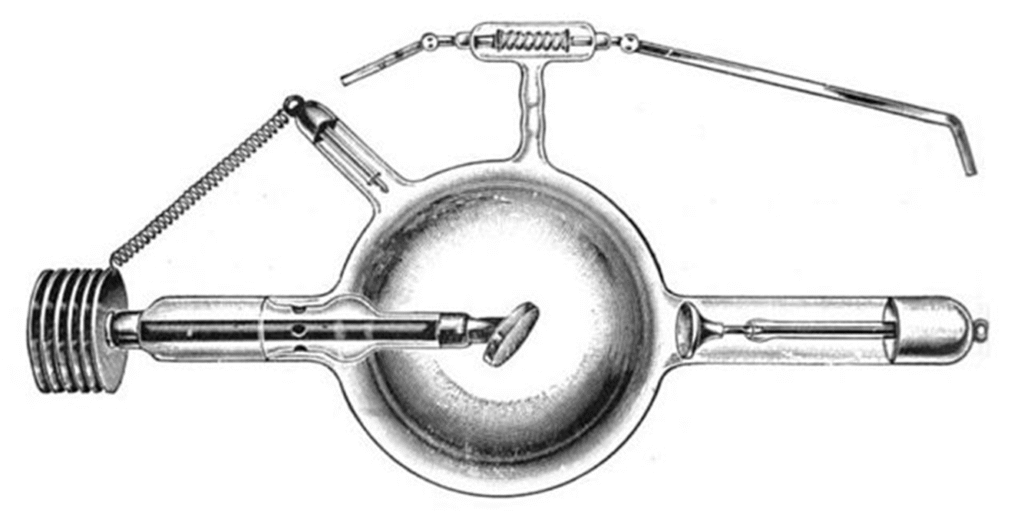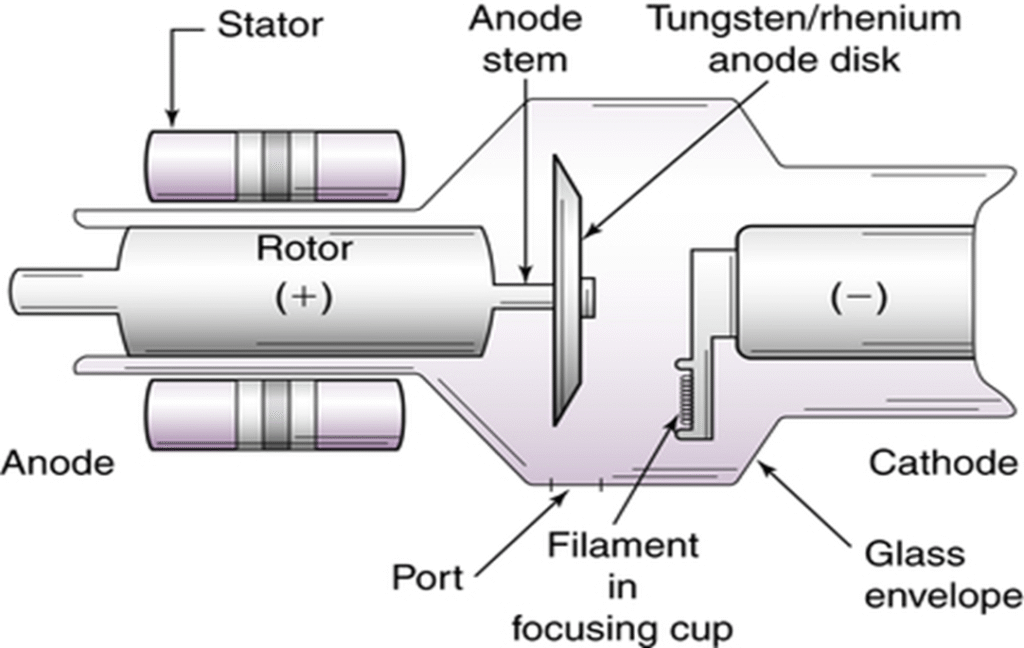Introduction
X-Ray tube Is a device which is meant for the production of x-rays.
It is an vacuum tube.
Contains a pair of electrodes i.e. cathode and anode.
Cathode is a filament that releases electrons when high voltage is applied
Anode is made up of tungsten, which attracts the electrons.
when the electrons released from the cathode come in contact with the tungsten. they release energy in the form of photons.
when the electrons released from the cathode come in contact with the tungsten they release energy in the form of photons
These highly energized photons are channeled through a lead cylinder and series of filters creating xrays.
Principle
•X-ray tube is a device based on the principle of energy conversion.
•When the fast moving electrons comes in the vicinity of the heavy nucleus, it gets attracted towards the positively charged nucleus due to columbic force and gets deviated from its original path, In this process kinetic energy of fast moving electrons is lost and converted into heat(99%) and x-ray energy(1%).
X Ray Tube Design
An X-ray tube consists of two components:
1.Electron source(cathode) – is made of tungsten wire in the form of helical filament,surrounded by a focusing cup.
2.focusing cup controls the width of the electron distribution, and directs the electron toward the target.
3.Target to stop the electrons(anode)- Tungsten (W) is the metal widely used as target because of its high melting point, 3387°C and high atomic number, 7
4. high voltage supply to accelerate electrons
5.vaccuum and glass envelope (tube insert)- The tube insert or envelope is made up of borosilicate glass (Pyrex).
The tube insert:
- Absorbs the X-rays emerging in undesired directions,
- Maintains the required vacuum,
- Acts as an electrical insulator
- Also contain the cooling system which removes the heat from the target.
Space Charge Effect
•When the applied kV is zero or small, the electrons surrounding the filament forms a cloud, resulting in space charge effect.
•These electrons tend to repel electron back into the filament and hence the tube current is very small.
•Above 40 kVp, the space charge effect is overcome, and the tube current is controlled by the filament current. This is called the saturation
Line Focus Principle
It states that as the anode angle is made small, the apparent focal spot also becomes small but with increased heat loading.
this slope allows x-rays produced at focal spot to leave the tube sideaways in such a way that the x-ray beam emerges at right angle to the long axis of the xray tube
permits large ares for the electron bombardment and a small x-ray source.
typically 7-15 degree.
Heel Effect
•The heel effect refers to the reduced intensity of the X-ray beam towards the anode side of the X-ray field
•The X-ray photons that are emitted on the anode side of the field must pass through a greater thickness of the anode than those directed toward the cathode side.
•This results in a reduced intensity on the anode side of the field.
Historical X Ray tube
GAS TUBE(ION TUBE) OR CROOKES TUBE
•Invented by british physicist Sir William Crookes.
•also called as cold cathode tube or discharge tube
•These tubes consist of two electrodes called cathode and anode, kept in a sealed glass envelope.
•The cathode is an aluminum stem carrying a concave aluminum disc.
• The anode or target is tungsten or platinum backed with copper.

Limitations
•Relatively low intensity of x-rays.
•was unreliable and unstable as x-ray production depended upon gas content.
•can not produce X-rays continously
•kv and mas can not be operated independently due to presence of gas.
THE COOLIDGE TUBE(hot cathode X-ray Tube)
•also called Hot cathode tube is the widely used, works with a very good quality vacuum.
•electrons are produced bt thermionic effect i.e. on heating metal element emit electrons.
•coolidge is the prototype for modern xray tubes being used today.
• high voltage is applied between the cathode and anode leads to flow of electron current from the cathode to anode.
•As the electron reaches the target, X-rays are produced.
•These tubes always works on saturation potential.
• the applied voltage and tube current are independent of eachother, and can be controlled separately, which is the advantage of this tube.
•All the modern X-ray tubes are based on the principle of Coolidge tube only.
MODERN X-RAY TUBE
- STATIONARY ANODE X-RAY TUBE
- ROTATING ANODE X-RAY TUBE
STATIONARY ANODE X-RAY TUBE
advantages
- compact Unit
- less cost
- low electric power
Applications
Dental x-ray set,small portable and mobile x-ray units with limited output where no sophisticated procedures such as rapid sequential imaging are required.
Limitations
Since area covered by electron beam on the target i.e. x-ray source and the area over which heat is spread are the same so we cannot use higher electrical load or high mAs.
CONSTRUCTION OF STATIONARY ANODE TUBE
Cathode consists of the following components:
Filament- made up of tungsten.
Focusing cup- made up of nickel
Glass Envelope
Used to enclose the vacuum within the xray tube
The envelope is joined to the copper anode at one end and the nickel cathode support at the other re-entrant seal.

•When the filament is heated,it emits electrons.
•The focusing cup produces an electric field that focuses the electron to the focal area.
•If the anode made positive with the respective to the filament, these electrons will be attracted to the anode .
•This will constitute the electron current flowin the anticlock wise direction.
•The electron which are accelarated by their applied voltage possess high kinetic energy.
•When they suddenly stopped in the target,x-rays are emitted in all directions.
•During the procedure, a large amount of heat is produced in the target.
•The tube is also provided with suitable cooling system to remove the heat very quickly.
Rotating anode x ray tube
•In 1933 rotating anode x-ray tube was invented.
•Anode is made to rotate before the electron is emitted.
•Developed to increase the heat loading with higher x-ray output.
•In these tube, the electrons transfer their energy over a large area of rotating target.
Principle
•Based on the principle of removal of target from the selection beam before it reaches too high a temperature by replacing it by another cooler target i.e. the target from the face of the rotating disc.
Cathode
•Tungsten filament facing towards the target.
•Usually, rotating anode tube are fitted with two filaments.
•First one is designed is designed to focus the electrons on a larger area of the anode
•The other filament is used to focus the electrons on a smaller area of target.
•This type is used when high resolution is required.
Focusing cup
•It surrounds the filament, shapes the electron beam width.
•Used to focus the electrons on a small area (focal spot) in the anode.
Anode
made in the form of large disk of tungsten, or an alloy of tungsten
It has a tungsten rhenium target area as tungsten has high melting point and atomic number.
In addition rhenium is used as it prevent crazing of the anode surface.
Rotor
•The anode disk is connected to a rotor, which is made up of copper bars arranged around a cylindrical iron core.
•The rotor rotates at a speed of about 3000–9000 revolutions per minute (rpm).
•The surface of the rotor is blackened to enhance heat dissipation by radiation process.
Anode Stem
•The anode disk is mounted on a stem, which is attached to the rotor.
•The anode assembly rotates with the help of bearings.
•The stem is made of molybdenum, which is having high melting point (2620°C) and poor heat conduction so it prevent the flow of heat from tungsten to the bearing.
•There are electromagnets surrounding the rotor, outside the glass envelope is called stator

Bearings
•The anode assembly is rotated with the help of bearings,which are made of steel ball races.
•Bearings are in the high vacuum environment and require special heat insensitive, nonvolatile lubricants.
•The bearings are coated with lead or silver to act as (metallic lubricants) lubricant.
•Commonly available lubricants such as oil and grease cannot be used,since it will vaporize while heating and destroy the vacuum.
GRID CONTROLLED X-RAY TUBE
•It contains three electrodes, the anode, cathode and the focusing cup.
•The focusing cup acts as a third electrode (grid), and controls the flow of electrons from the filament to the target.

